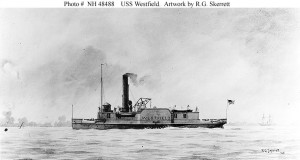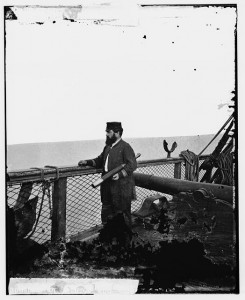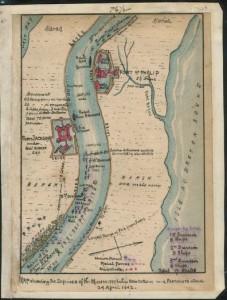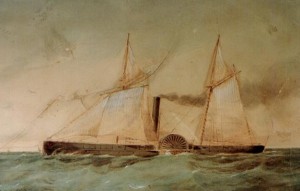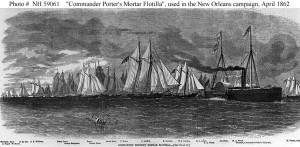150 years ago this fortnight a native son of Seneca Falls, New York wrote some letters home from far, far away at the mouth of the Mississippi River. JOHN was a mate in the Union navy that was preparing for an assault up the river to capture New Orleans, the largest city in the Confederacy. Steamers were towing other ships over the sand bar at the Mississippi’s mouth. The following letters were published by a Seneca Falls newspaper.
From Commodore Porter’s Fleet
The following letters will be read with interest, as coming from JOHN ARNETT, son of WM. ARNETT, of this village, who is now Master’s Mate on the U.S. Steamer Westfield, in Commodore Porter’s Fleet:
U.S. Steamer Westfield
March 30, 1862.
We are here in the Mississippi River, towing vessels over the bar at the mouth of the river. All of the bomb fleet are here with the exception of the steamer “Octorora,” which is the flag ship of the fleet. There are thirty sailing vessels and seven steamers in the fleet, besides the frigates Richmond, Pensacola, Mississippi, Colorado, Verona, Cayuga, and every day some vessel comes to join the Expedition. We are going to have a hard fight before we take New Orleans as the rebels are doing all in their power to beat us. Forts Jackson and St. Phillip are between us and New Orleans, and are very strongly fortified, and there are batteries all along the River from there to New Orleans. I was talking with a Pilot to-day, who is a prisoner that was taken while running the blockade; he told me that just below the forts they had constructed a large raft composed of drift-wood fastened with chains, and so arranged that they can let it all break and come down on the fleet when the attack commences. The story is verified as we do not see any drift-wood floating down the River, which at this season of the year is usually full of it. The weather is warm and pleasant. All of the houses are closed around here, and the owners, with their families, have gone to New Orleans. There is a little Rebel steamer that runs in sight of us every day, and when one of the gun-boats makes a start she will “make tracks” up the river, as she is a fast sailor. I wish we could get her within range of our one-hundred-pound rifle gun once. We have to work slow, as there is almost always a donse [sic] fog here on account of the fresh water uniting with the salt, and some of the large ships are hard around, and we have plenty of work to do. I think before this reaches you the battle will be fought, as everything is working with all possible despatch [sic], so as to avoid the hot weather and get up the River before June. This mortar fleet is a “big thing.” I think the frigates will go ahead of us as we shall have the second division of Mortar schooners to tow. The mortars can throw two-hundred-pound shells four miles with accuracy at a target, and twice that distance with a full charge. I saw one of the shells strike a small house, and the way the shingles and boards flew was a caution. I am very well contented, and anxious for the ball to open. I have been on the sick list but once and that did not last twenty hours. An unfortunate accident occurred yesterday. One of the Mates in casting off a hawzer [hawser], had his hand badly smashed
Yours &c.,
JOHN
____________________
U.S. Steamer Westfield
April 5, 1862.
We are at anchor in a dense fog up the River a few miles, and this is the first quiet day I have had in some time, as we have been very busy towing vessels over the bar. It is Sunday, and thinking a few lines to you would be better than “turning in,” (as I have just come off the watch) I sit down to write:
We had general muster service and and inspection service this morning – how unlike the Sundays at home – tracts are distributed, and the sailors read them (as a general thing) with much interest. We do not carry a chaplain, as our vessel is not allowed any, but we have some very good men on board. The weather is warm, and I regret that I did not bring some light clothing along, but I think I can get a suit made on board. How would you like to see me in a roundabout again? That is the Navy style of summer coats. We shall be away from here when the hot weather sets in if we are successful in taking New Orleans, which we will without doubt before this reaches you.
A little skirmish took place yesterday a little further up the river between one of our steamers and a Rebel Gunboat, but the …[missing data from newspaper clipping]… make the attack on the forts in a few days, and when they are taken New Orleans is ours if Commodore Foote does not get the windward of us. Please give my kind regards to Mr. JENNINGS, and say to him that I have seen WM. PENFIELD once again and he seemed glad to see me, he is coming to see me to-morrow again, and wished me to give his regards to Mr. JENNINGS and family.
Yours, &c.,
JOHN
____________________________
April 9, 1862.
Nothing of importance has transpired since writing the foregoing. We have got the vessels all over. General BUTLER arrived yesterday and reported to the Commodore that his forces were all ready, and when they arrive and we coal and mount four more guns, we shall be ready to move up the river. My health is very good, and has been since I left home, while my old complaint is entirely cured. I am very well contented and have the good will of every one on the ship. God bless and preserve you all.
JOHN

